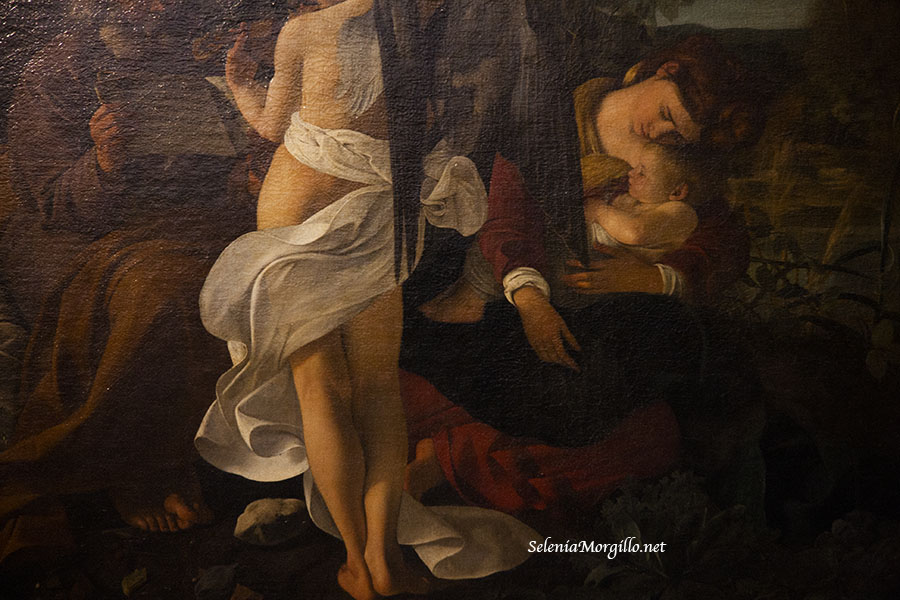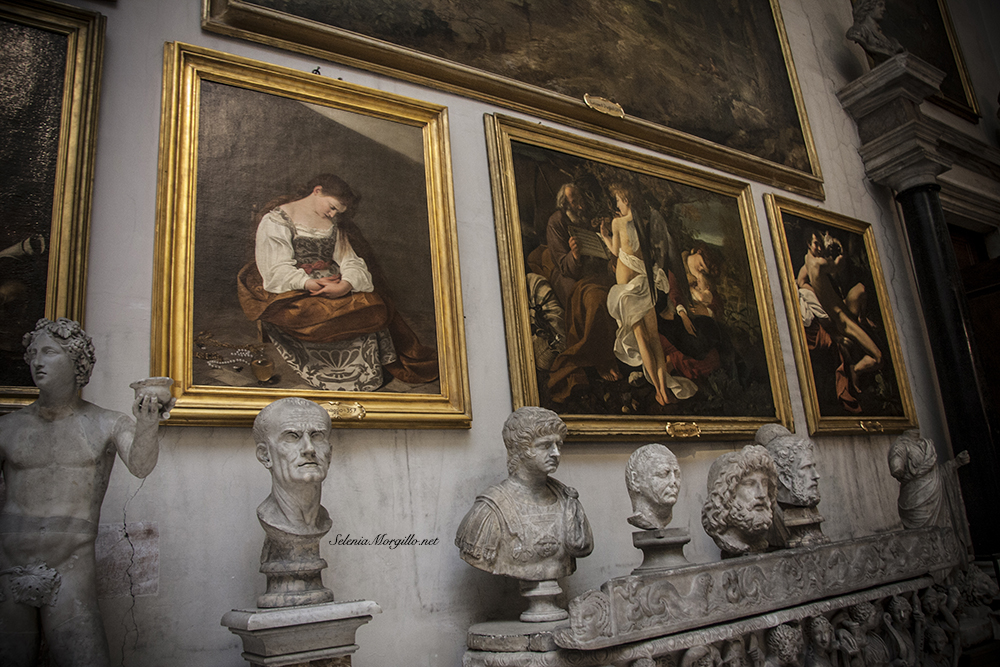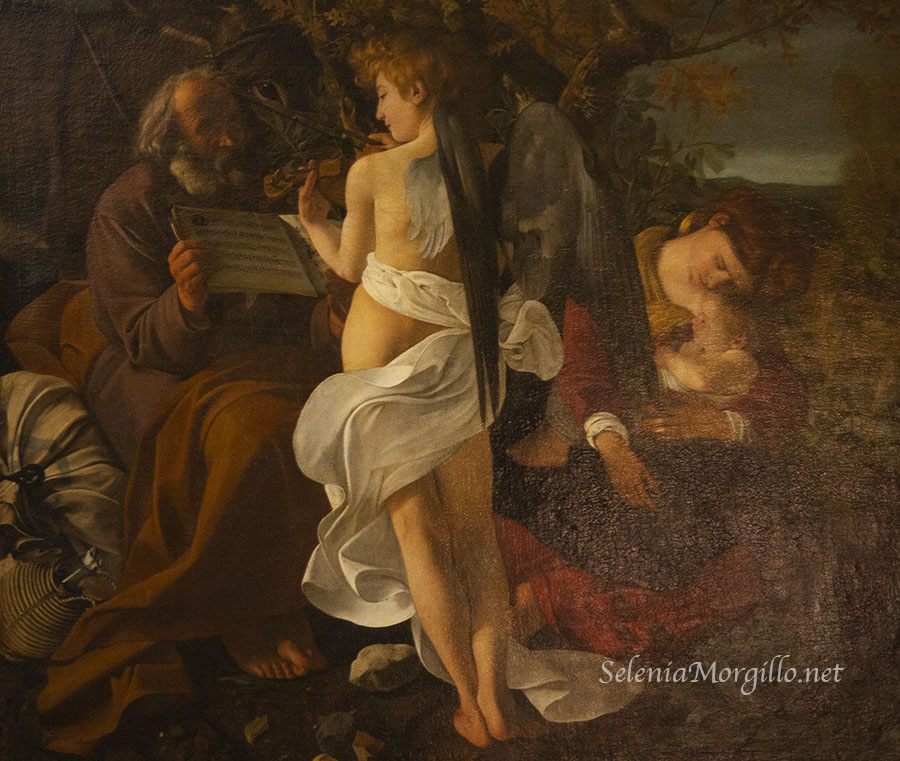Caravaggio in Rome, The Rest on the Flight into Egypt
Italian Version Below*
The Doria Pamphilj Gallery in the center of Rome, along the famous Via del Corso, is a place of invaluable value for me. For some business events, I have learned to know that place very well in recent years and I have fallen in love!
When I walk around the rooms, practically alone, I wonder where the tourists are, too busy between the Colosseum and the Vatican Museums, the heart has saddened several times but over time has learned to see the glass half full, tourists are few and an art historian enjoys this privilege.
Paradoxically, the best use of art is alone, in a place that allows you to contemplate the masterpieces without the crowd for as long as you want, comfortably seated.
At the end of the journey inside the Pamphilj Gallery, I always find myself in front of something that makes my heart beat faster, The Rest on the Flight into Egypt by Caravaggio.

Although the exhibition hall is not the best as well as the setting up, the power of the Caravaggesque genius is such that I forget everything that could be improved.
I sit and look at the picture continuously. Then I get up, get closer, I always need to get lost in looking at those wonderful details.
Caravaggio’s life is daring, it fascinates everyone, it is simply brilliant and sometimes full of chronological uncertainties. However, a fixed point exists. His very long and conspicuous Roman stay.
In the second half of the 1590s, Monsignor Fantino Petrigniani rents a room in Caravaggio, according to the story of the biographer Mancini.
It is in this context that “The Rest on the flight into Egypt” was born.
Maria rests in this escape, the model is Anna Bianchetti again.
Maria in extreme tenderness cradles the baby. In the center of the painting, there is an angel standing and playing the violin, placed from behind, extraordinarily beautiful. In his appearance, we wanted to recognize the same personage represented in the Bari.
San Giuseppe seated holds the score as if it were a lectern. In the score that is not a random score, a Marian piece is identified from the Song of Songs – “How beautiful you are”. The music is by a Flemish composer who lived in the early 1500s.

Caravaggio’s attention to detail is endless. Most likely he asked the Cardinal del Monte, his patron in town, to borrow the score.
To the right of the angel is the Old Testament symbolically represented by the arid and lifeless stones and the earth in memory of slavery in Egypt.

As if in a dream, I wake up and keep wandering around. I am only spoiled for choice, Raffaello, Carracci, Velazquez, Bernini, Algardi.
All rights reserved*
La Galleria Doria Pamphilj in pieno centro a Roma, lungo la famosissima Via del Corso, è un luogo per me di inestimabile valore. Per alcune vicende lavorative ho imparato a conoscerlo molto bene negli ultimi anni e me ne sono innamorata.
Quando girolozolo per le sale, praticamente in solitaria, mi chiedo dove siano i turisti, troppo impegnati tra il Colosseo ed i Musei Vaticani, il cuore si è intrististito diverse volte ma con il tempo ha imparato a vedere il bicchiere mezzo pieno, i turisti sono pochi ed uno storico dell’arte, gode di questo privilegio.
Spesso paradossalmente la miglior fruizione dell’arte è in solitaria, in un luogo che ti permette di contemplare senza la calca i capolavori per tutto il tempo che vuoi, comodamente seduto.
Al termine del percorso all’interno della Galleria Pamphilj mi ritrovo sempre dinanzi a qualcosa che mi fa battere il cuore, Il Riposo durante la Fuga in Egitto di Caravaggio.

Nonostante la sala espositiva non sia delle migliori così come l’allestimento, la potenza del genio caravaggesco è tale che dimentico tutto quello che potrebbe essere migliorato. Mi siedo e guardo ininterrottamente il quadro. Poi mi alzo, mi avvicino, ho sempre bisogno di perdermi a guardare in quei meravigliosi dettagli.
La vita di caravaggio è rocambolesca, affascina tutti, è semplicemente geniale e talvolta piena di incertezze cronologiche. Un punto fermo però esiste. Il suo lunghissimo e cospicuo soggiorno romano.
Nella seconda metà degli anni 90 del 1500 il monsignor Fantino Petrigniani affitta una stanza a Caravaggio, secondo il racconto del biografo Mancini.
È in questo contesto che nasce Il Riposo durante la fuga in Egitto.
Maria si riposa in questa fuga, la modella è nuovamente Anna Bianchetti. Maria in una tenerezza estrema, culla il bambino. Al centro del dipinto c’è un angelo in piedi che suona il violino, posto di spalle, straordinariamente bello. Nelle sue sembianze si è voluti riconoscere lo stesso personaggio rappresentato nei Bari.
San Giuseppe seduto gli tiene tiene lo spartito come fosse un leggio. Nello spartito che non è uno spartito a caso, è identificato un pezzo mariano dal Cantico dei Cantici – “Quanto sei bella”. La musica è di un compositore fiammingo vissuto all’inizio del 1500.

L’attenzione ai dettagli di Caravaggio è senza fine. Molto probabilmente ha chiesto in prestito lo spartito al Cardinal del Monte, suo mecenate in città.
Alla destra dell’angelo è l’Antico Testamento simbolicamente rappresentato dalle pietre aride e senza vita e dalla terra in ricordo della schiavitù in Egitto.

Come in un sogno mi risveglio e continuo a gironzolare. Ho solo l’imbarazzo della scelta, Raffaello, Carracci, Velazquez, Bernini, Algardi.
Sostieni la #culturachevince, aiuta la condivisione.
Tutti i diritti sono riservati. E’ vietata qualsiasi utilizzazione, totale o parziale, dei contenuti inseriti nel presente portale, ivi inclusa la memorizzazione, riproduzione, rielaborazione, diffusione o distribuzione dei contenuti stessi mediante qualunque piattaforma tecnologica, supporto o rete telematica, senza previa autorizzazione scritta di Selenia Morgillo.